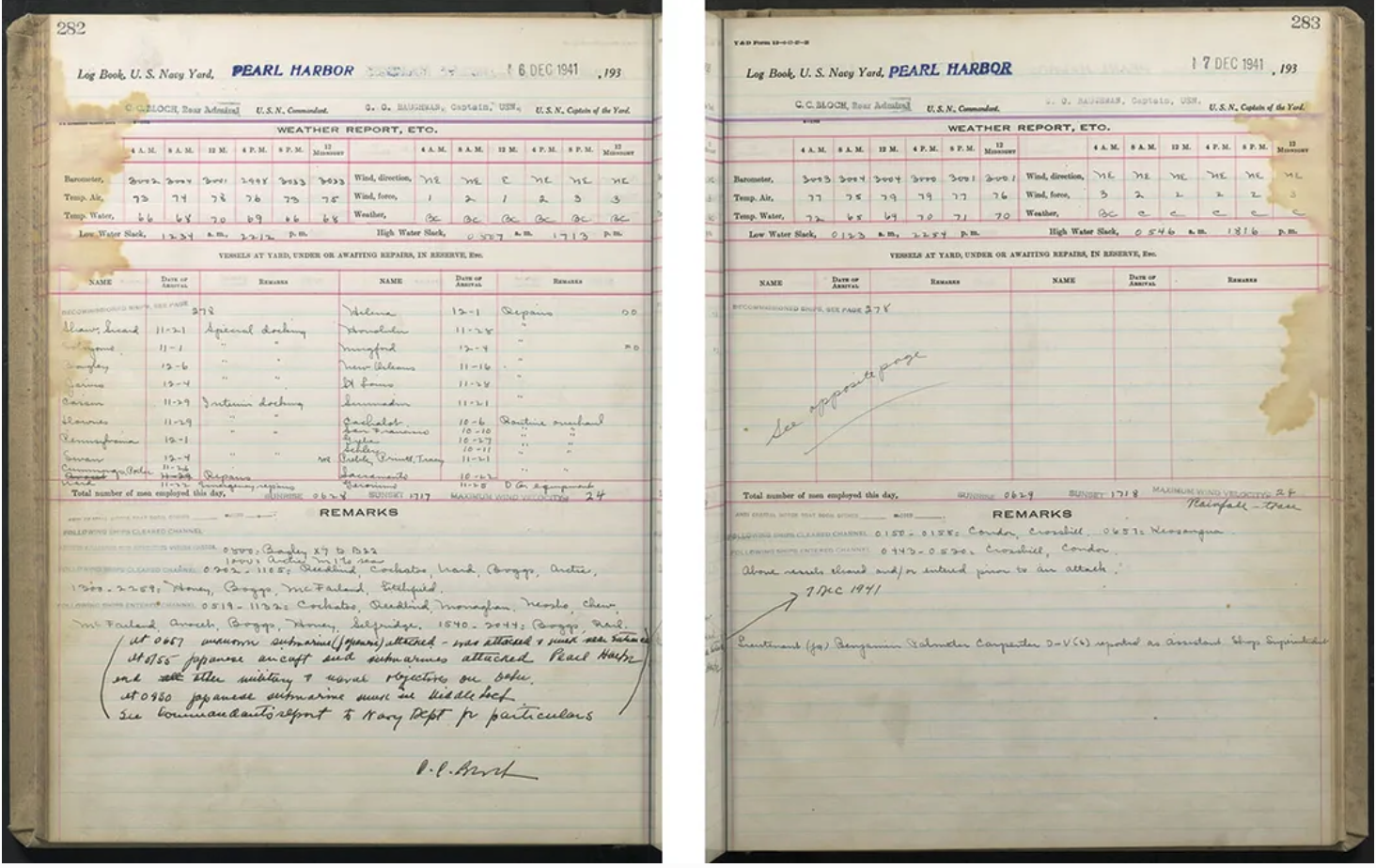She Found a Tattered Logbook in the Trash. It Turned Out to Be a Rare Record From the 1941 Pearl Harbor Attack

Source: National Archives
The National Archives has recovered the volume, which includes more than 500 pages of data from March 1941 to June 1942. It had been tucked away in storage for half a century
In the 1970s, Oretta Kanady was working at the Norton Air Force Base in San Bernardino, California, when she noticed an old logbook in the trash. She didn’t know what it was, but she asked her superiors if she could keep it. They said yes.When she got home, she gave the tome to her teenage son, Michael William Bonds. He never examined it closely—but he kept it.
“I’ve had it ever since,” Bonds, now 65, tells the Washington Post’s Michael E. Ruane. “In the last few years, I’ve moved here, moved there. It’s just been in a box.”
The volume turned out to be a logbook from the naval base at Pearl Harbor in Hawaii. Now, half a century later, the National Archives has recovered the text, which includes records from before, during and after the attack on December 7, 1941.
At more than 500 pages, the logbook contains “regular, handwritten entries from March 1941—when war in Europe was raging but prior to the entry of the United States—to June 1942 at the Battle of Midway,” according to a statement from the National Archives.
Bonds didn’t recognize the logbook’s significance until last year, when he moved in with his fiancée, Tracylyn Sharrit, in Hemet, California. She was helping him unpack his books when she noticed the mysterious volume. Every page that had been filled in featured a stamp at the top, which read either “Pearl Harbor” or “Pearl Harbor, T.H.”—short for Territory of Hawaii.
The logbook recorded the barometric pressure, air temperature, water temperature, wind direction, wind force and weather every four hours, as well as the names of the ships that came and went each day. It also featured a section at the bottom of each page titled “remarks.”
On December 6 and 7, 1941, the “remarks” sections contained the following notes: “At 0657 unknown submarine (Japanese) attacked—was attacked and sunk near entrance. At 0755 Japanese aircraft and submarines attacked Pearl Harbor and other military and naval objectives on Oahu.”
Sharrit was stunned. Could this kind of contemporaneous account be valuable? The couple contacted experts at Whitmore Rare Books in Pasadena, California, to find out.
“When someone reaches out and says, ‘Hey, we’ve got the station logbook during the attacks of Pearl Harbor,’ your ears perk up,” Dan Whitmore, the founder of the company, tells the Washington Post, which first reported the discovery. “That’s a significant cultural object.”
Whitmore wasn’t sure how much it was worth, though he wondered if it could be a lot—maybe even six figures. But there was one complication: He worried the book could still be considered government property. When Whitmore contacted the National Archives, he learned that his hunch had been correct. A special agent with the National Archives flew to California, and the couple handed over their discovery. As gratitude, they received two National Archives T-shirts.
“This special item is one of the few surviving records that helps tell the story of the ‘date which will live in infamy,’” says Jim Byron, a senior adviser at the archives, in the statement. “Thanks to the efforts of [a] historically conscious California couple, it is now available to the American people, allowing everyone to better appreciate their history—and especially the sacrifice and heroism of December 7, 1941.”
Bonds wishes he could have gotten some sort of compensation for the discovery. After all, without his mother’s keen eye, “it would have been gone and nobody would have ever seen it again,” he tells the Washington Post. “All I got was a T-shirt so far.”
But officials are thankful that the logbook has returned to the National Archives, where it was formally unveiled in August. The digitized pages—along with typed transcriptions of the entries from December 6 through 14, 1941—can be found on the archives’ website.
Navy logbooks from World War II have been a vital resource for researchers in recent years. In 2017, the National Archives declassified a trove of 192,500 pages of U.S. naval records. Many of them had been written by sailors based in Pearl Harbor during the 1940s. In 2023, thousands of volunteers helped researchers digitize the data, which has helped scientists learn more about the climate during the war years.
“The greatest respect must go to the brave servicemen who recorded this data,” said lead researcher Praveen Teleti, a climate scientist at the University of Reading in England, in a 2023 statement. “War was all around them, but they still did their jobs with such professionalism. It is thanks to their dedication and determination that we have these observations 80 years on.”
Source: smithsonianmag.com. Ellen Wexler - Assistant Editor, Humanities
